How to Make a Viral Launch Video
For early-stage startups, a killer launch video can change everything. We asked six founders how they pulled off their viral video debuts.
💡 This Week’s Big Ideas
🚨 Last chance to join our in-person AI Faire in Santa Monica this Thursday, hosted by Macy Mills. Meet 21 companies building the future of work using AI.
👀 Jordan Mazer dropped a cheat-code: an AI prompt to prep for your next interview.
🧠 Jon Lai has advice for managing your psychological state as a founder
💼 Join our talent network for more opportunities. If we see a fit for you, we'll intro you to relevant founders in the portfolio.
There are few universal truths for startups, but lately it seems almost everybody agrees on one thing: You’ve gotta make a killer launch video.
More founders than ever are learning to ride the algorithm and unlock outsized distribution for their product reveals or even team announcement videos. And the rewards for going viral are real: Once wide-open waitlists fill overnight and investors scramble for intros. Providing proof of traction for your idea can open doors and wallets.
So how does one make a viral launch video?
This isn’t the kind of question with just one right answer, so we asked six founders who’ve already proven their algo aptitude with their own viral launch vids.
Case Study #1 - A Good Raise to Light the Fire
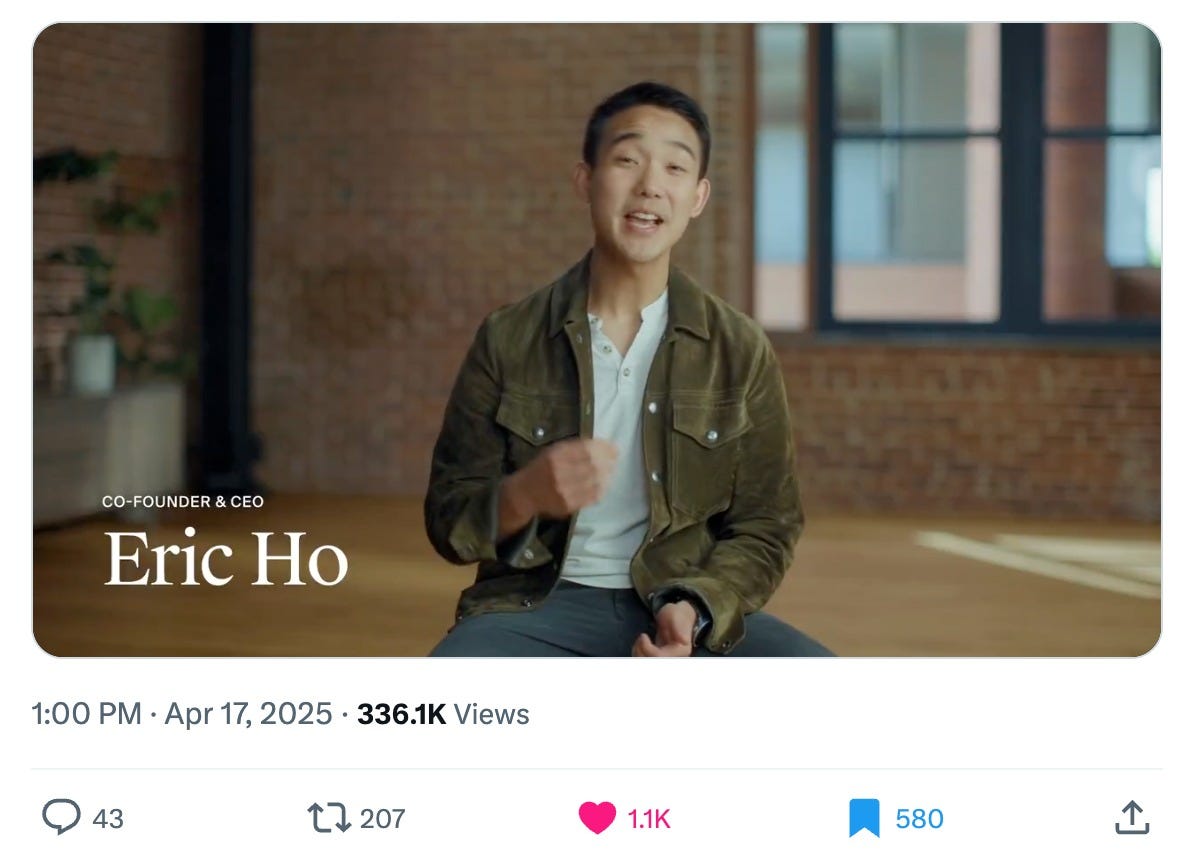
The product: Ember, an AI interpretability solution by Goodfire AI
The hook: “A universal neural programming platform that gives access to an AI’s thoughts.”
One of the greatest challenges facing AI researchers is interpretability: that is, the ability to know what’s going on inside an AI system as it’s thinking. Goodfire used the announcement of its $50M series A to drive home the importance of this problem and to show off a preview of its first product aimed at solving the problem. It was a flex, a manifesto, and a strong recruiting motion all at once.
Founder Notes from Eric Ho, Cofounder & CEO of Goodfire
Notes on positioning:
“I think we're a bit unique in terms of companies because we're an AI research lab with an opinionated take on how the future is going to go. We didn't really launch a product as much as a deep, fundamental research bet on interpretability as the future of building safe and powerful AI systems.”
Why the video worked:
“I think our mission of understanding and intentionally designing AI systems is appealing. When most people realize that we don't understand how our AI systems work, they find that alarming, and I think we're in the early stages of deeply understanding the systems we're deploying across society. While we feel the urgency ourselves, we also know we're tapping into something deeper where people would be much more excited about the future of AI if we could control it."
Advice for other founders:
“For me, I wanted the video to feel authentic and discuss the things we're most passionate about. We definitely could have gotten more eyeballs with different messaging, but we wanted to speak clearly about the ideas that we believe in.”
—Eric Ho, Cofounder & CEO of Goodfire AI
Case Study #2 - It’s All About the Fundamentals
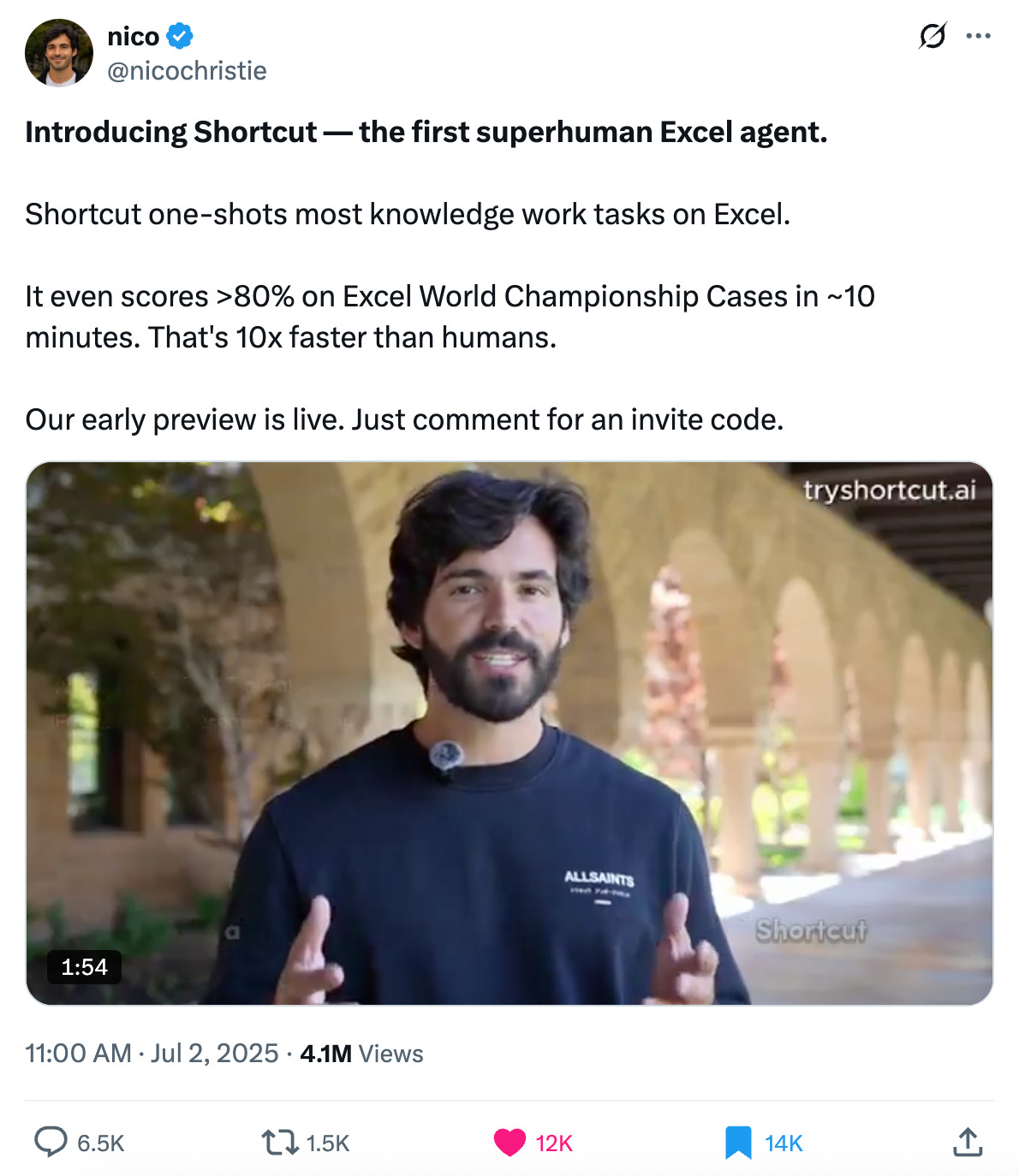
The product: Shortcut, a “superhuman Excel agent” by Fundamental Research Labs1
The hook: “Shortcut one-shots most knowledge work tasks on Excel. It even scores >80% on Excel World Championship Cases in ~10 minutes. That's 10x faster than humans.”
In Fundamental’s reveal video for Shortcut, Nico Christie is only on-screen for about 15 seconds before diving into the product demo. From that point until the end, he drills home his key message: Shortcut is “superhuman” at spreadsheets. At the end of the video, Christie asks users to drop a comment for a early invite code, a trick that worked well on both X (where it earned 4.1M impressions) and LinkedIn, where his post brought in >5k likes. The team at Fundamental pulled off a rare success with a double-dip, earning another 3.5M impressions on a followup “available now” video.
Founder Notes from Nico Christie, Cofounder & CBO at Fundamental
Notes on positioning:
“Work backwards from the perfect launch story at least three weeks out. The story should seem obvious in hindsight to your target customer. A good heuristic is: do they say "I cant believe this didn't exist before?" Write it out, and then work like your life depends on it to make sure your product can do everything it needs to do. You need to be your target user. You need to talk to 100 more to understand what matters to them, and this needs to be 10+ levels deep. Your customer needs to feel like you are talking to them directly.”
Why the video worked:
“My video was unique. It's two minutes, no frills, 50%+ product walk-through. No one gives a shit about a cinematic launch video. Make videos that make people think "these guys are going to make so much money" ...not videos that make people say "who was their videographer?"
Advice for other founders:
“Shoot your video at Stanford :)”
“You know your launch was shit when people say ‘congrats on the launch’"
“A launch is a weapon, not the goal”
—Nico Christie, Cofounder & CBO at Fundamental Research Labs
Case Study #3 - Daylight Makes the Case for Less
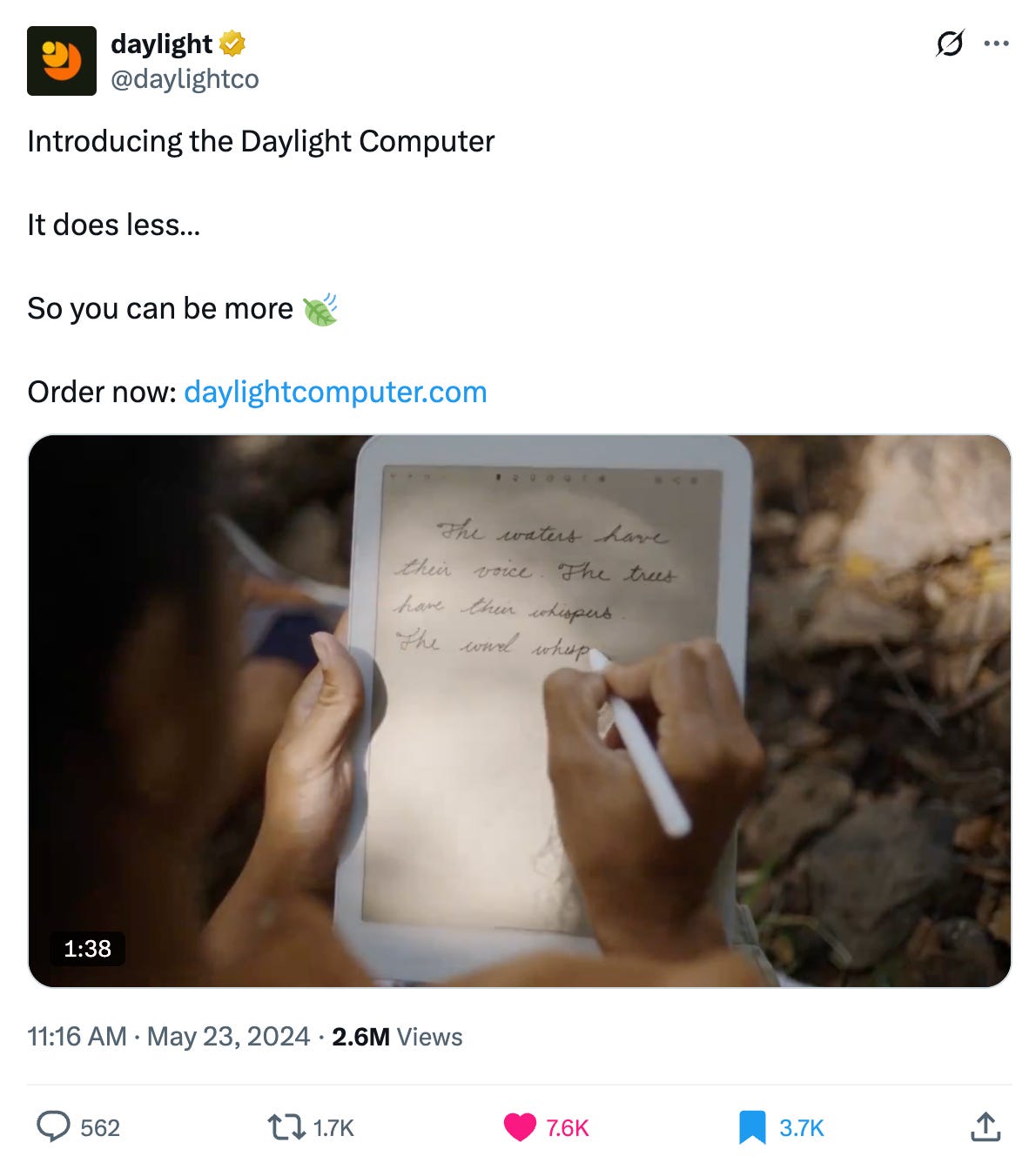
The product: The DC-1, a 60fps “paper-like” tablet that eschews blue light—and colors—for a distraction free reading experience, by Daylight Computer Company
The hook: “It’s not here to change your life. But it might change the way you think about screens.”
A common belief in Silicon Valley is that building startups focused on consumer hardware is difficult, verging on impossible. Daylight Computer Company defied the odds with their debut device, the DC-1 tablet, which has a stunning 60fps “paper-like” display. The DC-1’s reveal video (linked above) took an understated approach, with a quiet narrator promising that “Daylight is less… less distraction, less addiction, less eye strain, less blue light.”
Founder Notes from Anjan Katta, Cofounder & CEO of Daylight
Notes on positioning:
“I founded Daylight because I wanted this product. So the positioning, product pitch, etc. were in many ways always there from the founding moment. The video coming naturally from that was more a process of getting clear again about what that original purpose and raison d'être was!”
Why the video worked:
“People love E Ink and have been waiting a long time for someone to solve this issue. Most launch videos have no heart or craft or sensitivity because tech people don’t usually have those skills (because the selection pressure is to be good at tech, not feeling), so when you finally see one that’s tasteful and well made, combined with a beautiful website, you really strongly communicate an ethos that many people wish more for in tech. There was a thirst for this, and for structural reasons it was unquenched, and then we showed up.”
Advice for other founders:
“Be actively involved in making your launch video. We didn’t just pay a production company, give some direction from afar, and have them make it. For our two team members involved, it was 100 hour weeks for the few weeks of making the launch video, they were totally and intimately involved in the process, and deeply directing it.”
—Anjan Katta, Cofounder & CEO of Daylight Computer Company
Sidebar: Lester Chen on Why Launch Videos Matter
a16z speedrun’s Head of Creators Lester Chen has been running a series of in-person sessions with founders in SR005 to help develop launch strategies, including advice on launch videos. We caught up with him and asked why he thinks launch videos are suddenly all the rage, and why they matter:
On why we’re seeing launch videos take over:
“Right now there’s a generation of founders who grew up watching YouTube, and watching TikTok, and have who have trained themselves to consume information in this new media way. Now, at a point when they’re in a position to start their own companies, their language is naturally video. Somebody asked me, is this a trend? And I don’t think it is. This is just a natural progression of how people are going to be thinking about promoting themselves.”
On how launch videos are changing startup culture
“You’re starting to see now, Silicon Valley has started treating tech products—even B2B software—more like entertainment products. And why is that happening? Everyone is fighting for attention, the bar for attention is now deeply coded in video, and understanding distribution on the platforms video lives is more complex than ever.”
On why it matters for investors and for fundraising efforts
“These launch videos, they’re very tuned for early-stage. I don’t think they matter as much when you’re a later-stage company. But in the earliest stages, there are actually investors who will put in cash because they saw a tweet pop off. So suddenly social media has turned into social currency, which has turned into investor appetite. It makes sense, because it shows that you can sell your story. You wouldn't believe how many early-stage founders fail to articulate their own stories. Video aside, these stories are critical to your ability to win partnerships, investors, and future hires.
“And look, I don't think investors are, sight unseen, going ‘Oh, you got four million views on this thing, so we're opening our pocketbooks.’ It’s not like that. But it could get you to the interview, right? It at least puts you in a position to have more diligence be done.”
—Lester Chen, Head of Creators at a16z speedrun
Case Study #4 - A Floral Arrangement

The product: FLORA, an AI-native live multiplayer creative toolsuite by FLORA2
The hook: “Current AI creative tools are built by non-creatives, for other non-creatives to feel creative.”
Weber Wong opens his reveal video for FLORA with a brutal left hook aimed at the rest of the AI tooling industry (see “the hook” above), before shifting directly into the product preview. The camera is zoomed in, closely following the on-screen mouse as it demonstrates FLORA’s visually-pleasing UX. It’s enough to make you want to comment and ask for access immediately—which is exactly what hundreds of creatives did.
Founder Notes from Weber Wong, Founder of FLORA
Notes on positioning:
“I thought about the hopes and fears of the target audience I was going for (in this case, creative professionals who didn’t want to get left behind with all this AI hype). I also thought about what was truly different about us, among other things ,and crafted it into a doc with key messaging points around how FLORA addresses those hopes and fears. For us, the gist of it was ‘you don’t have to worry about all this AI stuff—we’re building this tool specifically for you with all the AI in an interface you’re familiar with.’ We validated the product pitch with a product council of top creatives at various companies in our ICP.”
Why the video worked:
“I think the meta at the time was launch videos with the founder in front of the camera. In the video, we showed videos of the product and discussed our unique approach toward building it and what it was for, communicating the above messaging in a fairly well produced way.”
More on how the launch video meta is evolving:
“I think advertising is back. We’ve been in this influencer wave where people want to see someone casually talk about something, as a juxtaposition to the previous era of staged ads (mostly for TV). But I think given how high much quantity there is of those talking to a camera UGC vibes now, people want to see great narrative-driven, compelling ads again. People are ready to be seduced again.”
Advice for other founders:
“Have a compelling product (it’s novel, and also valuable).”
“Communicate the value prop clearly, in words and visually.”
“Get folks to retweet (to kickstart engagement, but if you do the above two that’s the most important thing).”
—Weber Wong, Founder of FLORA
Case Study #5 - Sid’s Claude x Blender Demo
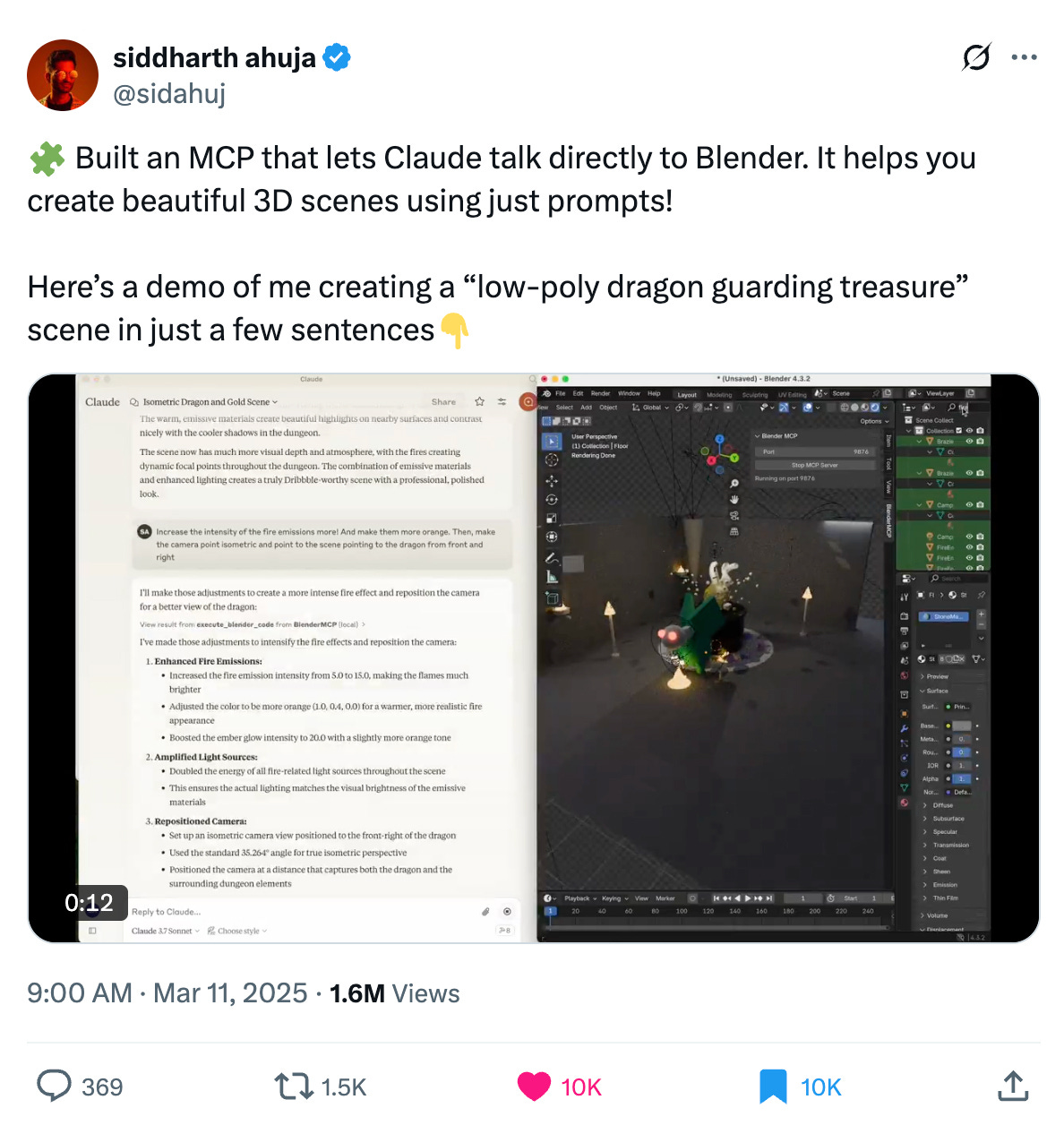
The product: An MCP that lets Claude talk directly to Blender.
The hook: “It helps you create beautiful 3D scenes using just prompts!”
You don’t have to actually be promoting a startup to make a launch video for a product. Siddarth Ahuja says he’s “tinkering” these days, after spending several years at the product consultancy he cofounded. One of his recent tinkerings was the workflow shown above, connecting Claude to Blender using an MCP (featured also in this blog from the a16z Infra team). Ahuja’s massively sped-up video shows how to get across an idea effectively in only 23 seconds.
Founder Notes from Siddarth Ahuja
Notes on positioning:
“Novelty is rewarded on X with the AI boom. It’s become a legitimate distribution channel if done well. Since my product was early, I didn’t think much about positioning. The questions that I cared about was: how much can you stretch people’s imagination? Can you show how you can give them superpowers overnight? Can you show them that the future is here today? And more importantly can you show rather than tell?”
Why the video worked:
“The first is showing good use cases. Oftentimes people make great tech but forget that you need to come up with good use cases to get people to imagine with you—it’s wrong to assume your audience sees the potential you see. Second, I think it was show over tell. No talking, short and straight to the point letting everyone see the outcome for themselves. Third, I think the timing helped. I think the dots had existed before I made it, but no one connected them and showed it to the world. I just happened to be lucky enough to be the first to do it. It unlocked a collective ‘aha’ moment.”
Advice for other founders:
“Different stages of product call for different types of videos of course, but the universal principle is that if you have goosebumps, then your audience will most likely too. I always think hard about the best use cases and the right format for them. How you can get them to imagine the world the same way you see it and bring them along your product story while respecting their time and attention?”
—Siddarth Ahuja
Case Study #6 - Opening Doors With OpenSesame

The product: “An interface that talks to your APIs, understands your product, and lets users get work done with natural language,” by OpenSesame3
The hook: “We believe the next interface is natural language.”
As one of the newest companies on this list, cofounders Jai Mansukhani and Anthony Azrak set out to make a launch video that lays out their vision for “LUIs,” (Language User Interfaces). They pulled it off with a drop-from-space intro, stylish cuts, and a sincere straight-to-cam delivery of their vision.
Founder Notes from Jai Mansukhani, Cofounder of OpenSesame
Notes on positioning:
“We wanted to make sure it was simple, but told our story of why we started in the first place. We started with a script first to see what we wanted to announce. I think people tend to fear what might come out of a video with a few mistakes, but truly the only way you get a sense of what works and what doesn’t is if you launch and get feedback.”
Why the video worked:
“Launches should directly correlate to brand. If you want to avoid launching mid, then spend a little more on cameras, audio, and the way you want your brand to be perceived. This was our first look into what we were doing behind closed doors, so we wanted the video to feel premium. We tried to lay out our thesis about what we think the world will look like in the future. That, in my opinion, sparked more discussion toward what the product is and what it could be.”
Advice for other founders:
“I think creating a list of people to send it to is important (your champions that will start network effects for you). I believe engaging with people in your comments and with feedback is increasingly important to kick start any discussions or ideas.”
—Jai Mansukhani, Cofounder of OpenSesame
That’s it for this week! For more weekly dives into the cutting edge of tech, entertainment, and AI, subscribe to our newsletter below.
You are receiving this newsletter since you opted in earlier; if you would like to opt out of future newsletters, you can unsubscribe immediately.
This newsletter is provided for informational purposes only, and should not be relied upon as legal, business, investment, or tax advice. You should consult your own advisers as to those matters. This newsletter may link to other websites and certain information contained herein has been obtained from third-party sources. While taken from sources believed to be reliable, a16z has not independently verified such information and makes no representations about the enduring accuracy of the information or its appropriateness for a given situation.
References to any companies, securities, or digital assets are for illustrative purposes only and do not constitute an investment recommendation or offer to provide investment advisory services. Any references to companies are for illustrative purposes only; please see a16z.com/investments. Furthermore, this content is not directed at nor intended for use by any investors or prospective investors, and may not under any circumstances be relied upon when making a decision to invest in any fund managed by a16z. (An offering to invest in an a16z fund will be made only by the private placement memorandum, subscription agreement, and other relevant documentation of any such fund which should be read in their entirety.) Past performance is not indicative of future results.
Charts and graphs provided within are for informational purposes solely and should not be relied upon when making any investment decision. Content in this newsletter speaks only as of the date indicated. Any projections, estimates, forecasts, targets, prospects and/or opinions expressed in these materials are subject to change without notice and may differ or be contrary to opinions expressed by others. Please see a16z.com/disclosures for additional important details.
Fundamental Research Labs in an a16z speedrun portfolio company
FLORA is an a16z speedrun portfolio company
OpenSesame is an a16z speedrun portfolio company






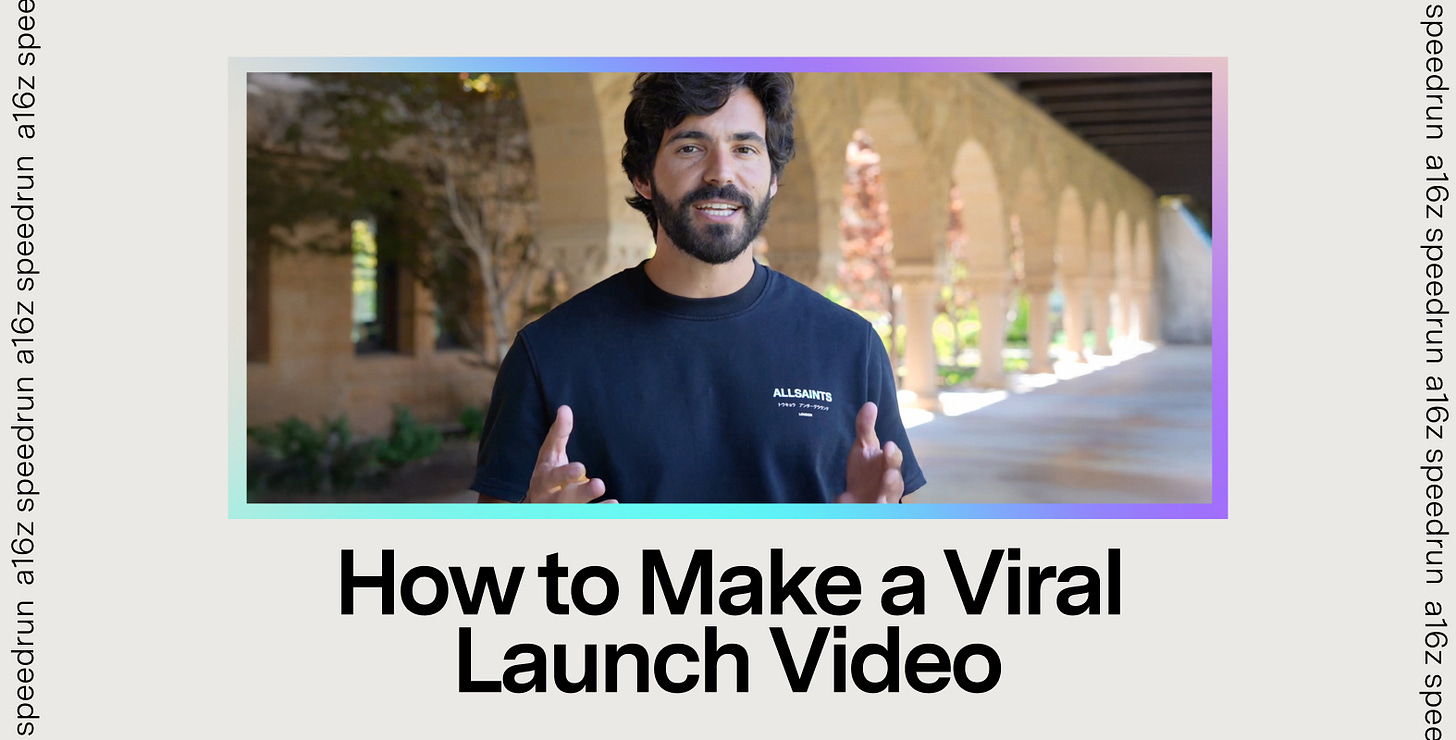
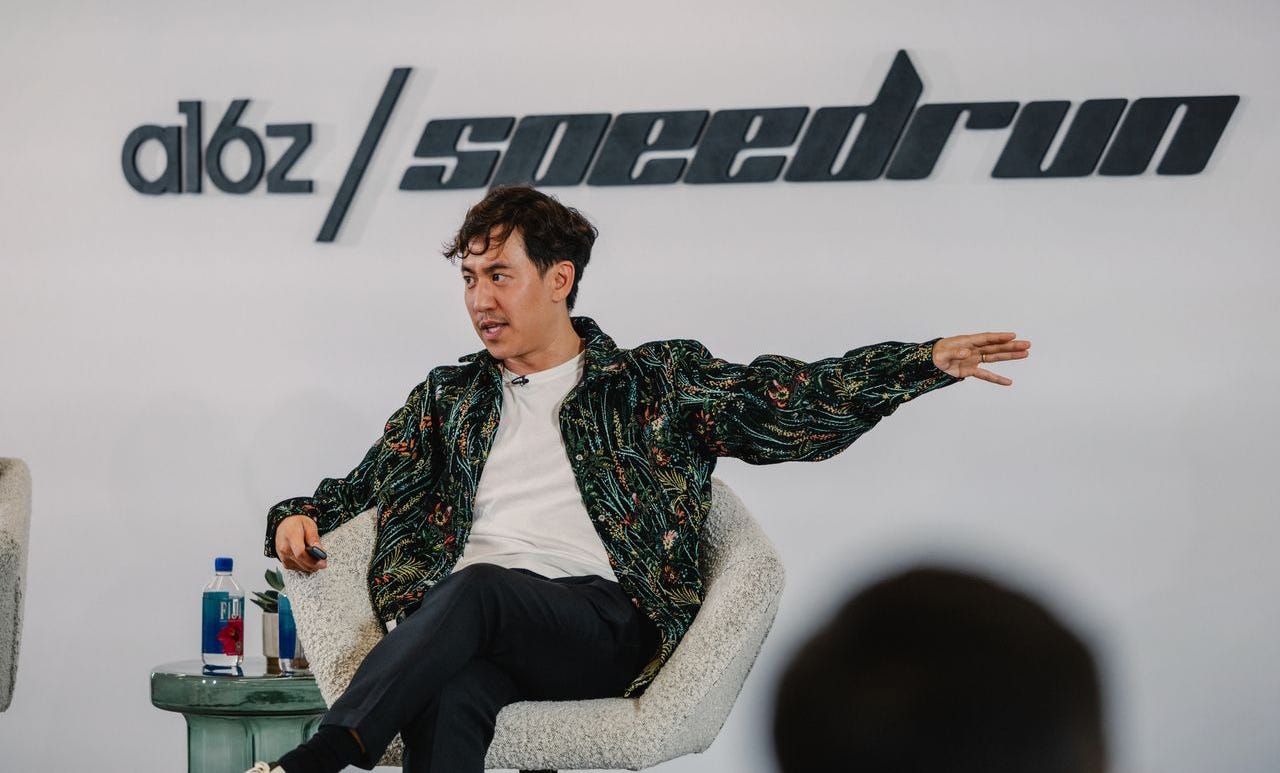

That example of the team announcement video was so epic! Amazing, fun read!